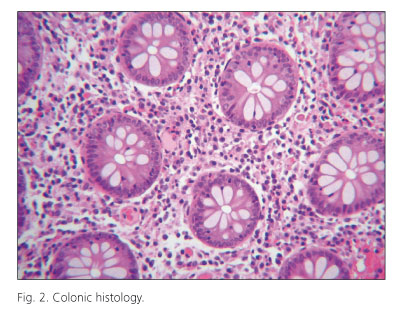Mi SciELO
Servicios Personalizados
Revista
Articulo
Indicadores
-
 Citado por SciELO
Citado por SciELO -
 Accesos
Accesos
Links relacionados
-
 Citado por Google
Citado por Google -
 Similares en
SciELO
Similares en
SciELO -
 Similares en Google
Similares en Google
Compartir
Revista Española de Enfermedades Digestivas
versión impresa ISSN 1130-0108
Rev. esp. enferm. dig. vol.103 no.10 Madrid oct. 2011
https://dx.doi.org/10.4321/S1130-01082011001000008
PICTURES IN DIGESTIVE PATHOLOGY
Atypical endoscopic findings of Crohn's disease
Manifestación endoscópica atípica de enfermedad de Crohn
Expiración González-Montero1, María Tejada-Cabrera1, Francisco Bueno-Márquez2, Alexis Piñero-García1 and Antonio López-Cano1
1Clínica Astarté. Cádiz.
2Hospital Universitario Puerto Real. Cádiz, Spain
Case report
A 48-year-old man with an unremarkable medical history was referred to our center for evaluation of 4-5 months history of diarrhea without any pathological products and abdominal pain. Laboratory analysis and abdominal ultrasound were normal. We did a colonoscopy and found an isolated diverticulum in the sigmoid colon. In distal areas of the right colon and cecum, there were multiple mucosal "bridges" which occupied the whole lumen like a mesh (Fig. 1), without further signs of inflammatory activity. Nevertheless, the ileocecal valve was more open than usual and showed a slight erythema. The terminal ileum was normal. The colonic histology (Fig. 2) displayed unspecified chronic inflammation, and the terminal ileum samples were normal. Our diagnosis, based on the clinical data and the endoscopic findings, was Crohn's disease without acute inflammation.
Discussion
Colonoscopy is an essential technique, allowing the diagnosis and assessing the extension and severity of inflammatory bowel disease.
In our case, the terminal ileum mucosa and the rest of the colon were normal, with the presence of multiple mucosal "bridges" and the ileocecal valve more open than usual as the only finding of inflammatory activity. The presence of these bridges is usually observed in patients with a long history disease and it is not related to the current activity. The most important finding in our case is the appearance of the mucosal "bridges", because of the number of them, their location in the right colon and cecum and their interlaced aspect, a strange endoscopic expression of this disease. From the histological point of view, ileal biopsies were normal and colonic biopsies showed only chronic inflammation. However, we know that biopsies of ileum and colon in Crohn's disease often are inconclusive and endoscopy is the essential diagnostic technique.
Recommended References
1. Geboes K, van Eiken P. Histopatología de la enfermedad de Crohn. En: Gasull MA, Gomollón F, Obrador A, Hinojosa J editores. Enfermedad inflamatoria intestinal. II ed. Madrid: Ergon; 2002. p. 193-207. [ Links ]
2. Leighton JA, Shen B, Baron TH, Adler DG, Davila R, Egan JV, et al. Standards of Practice Committee. American Society for Gastrointestinal Endoscopy. ASGE guideline: endoscopy in the diagnosis and treatment of inflammatory bowel disease. Gastrointest Endosc 2006;63:558-65. [ Links ]
3. Burakoff R. Indeterminate colitis: clinical spectrum of disease. J Clin Gastroenterol 2004;38 (5 Supl.):S41-S43. [ Links ]











 texto en
texto en 




